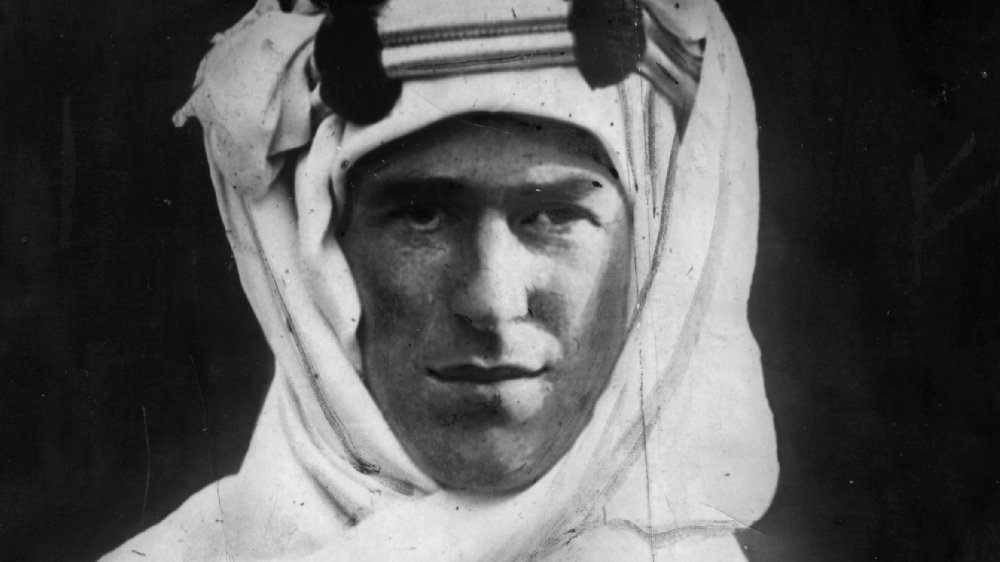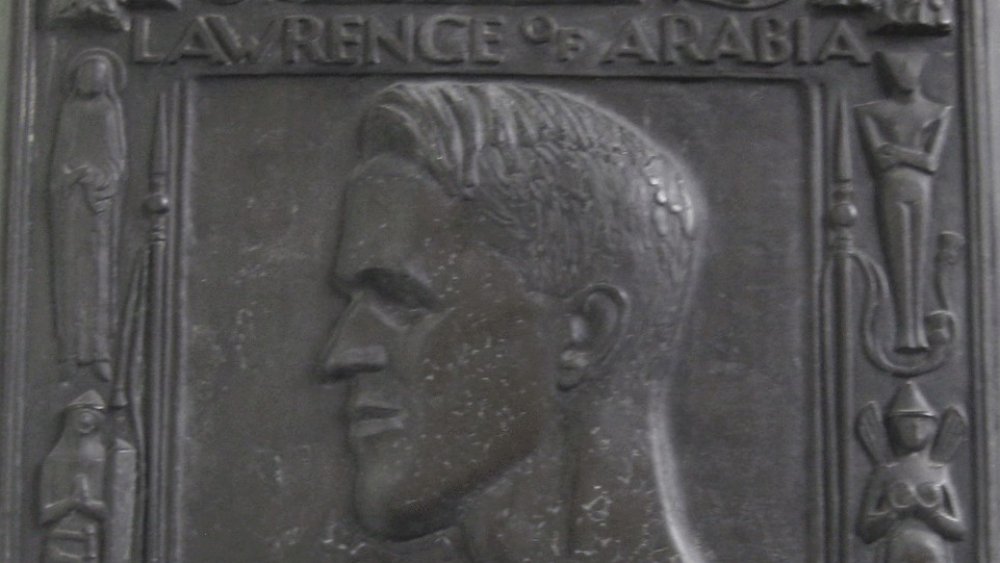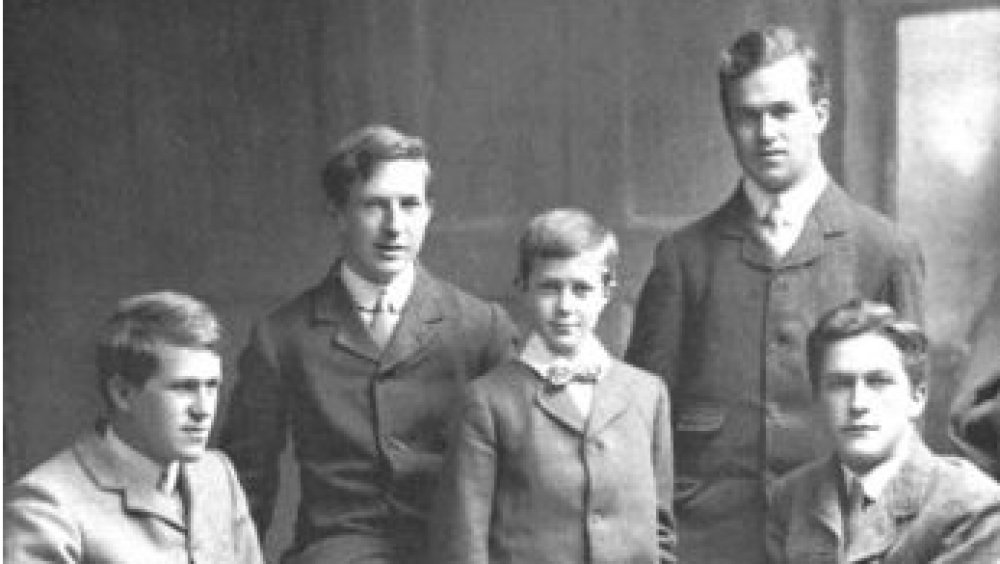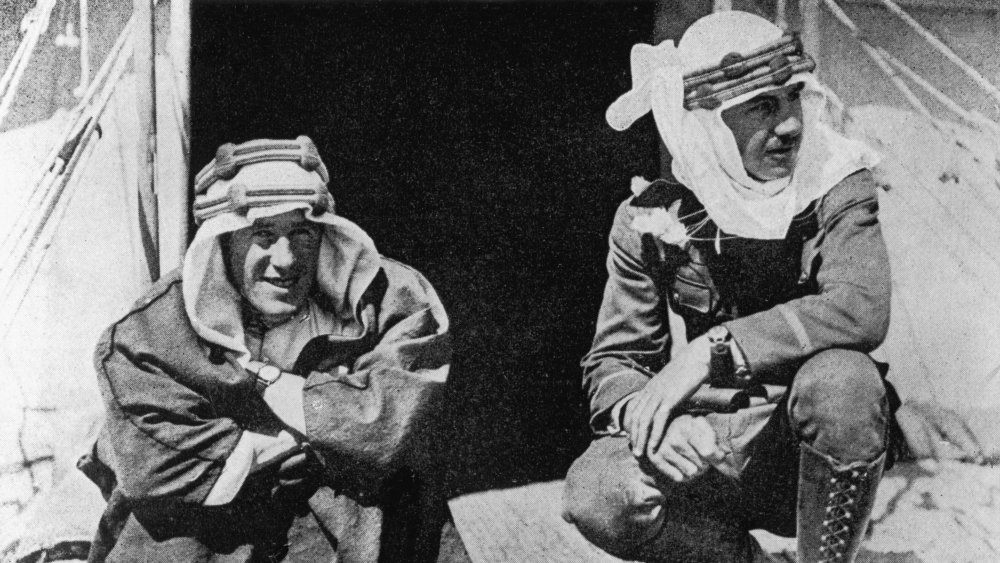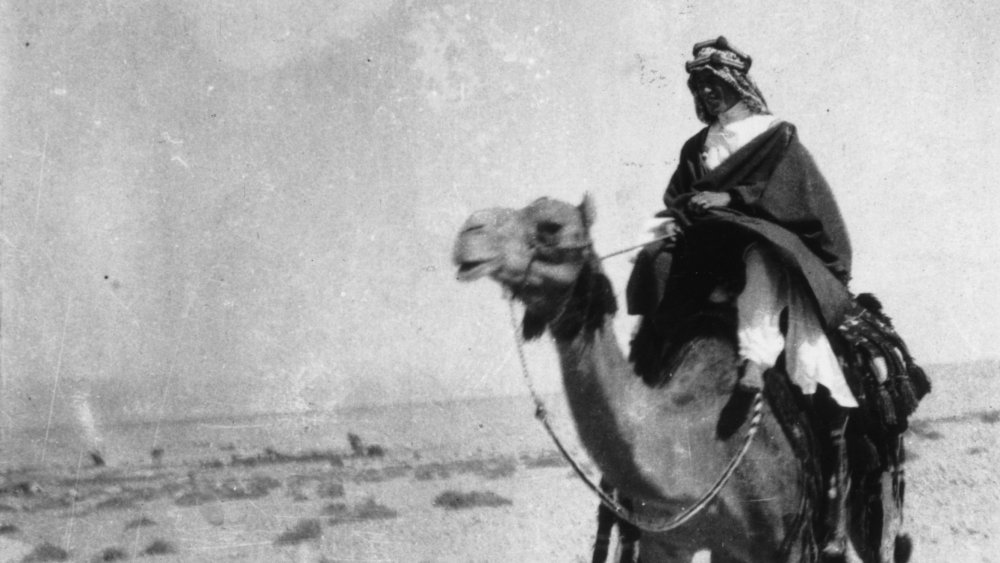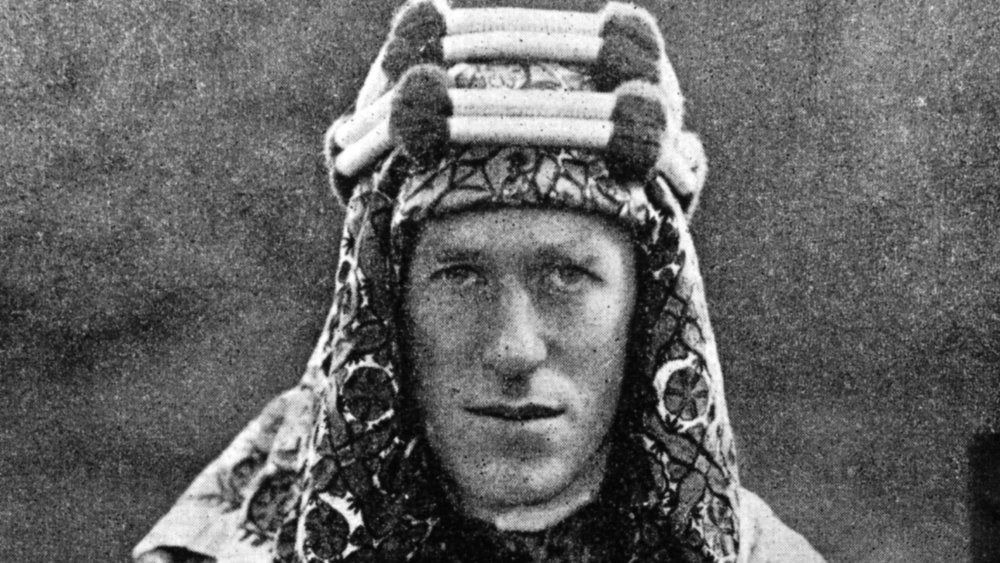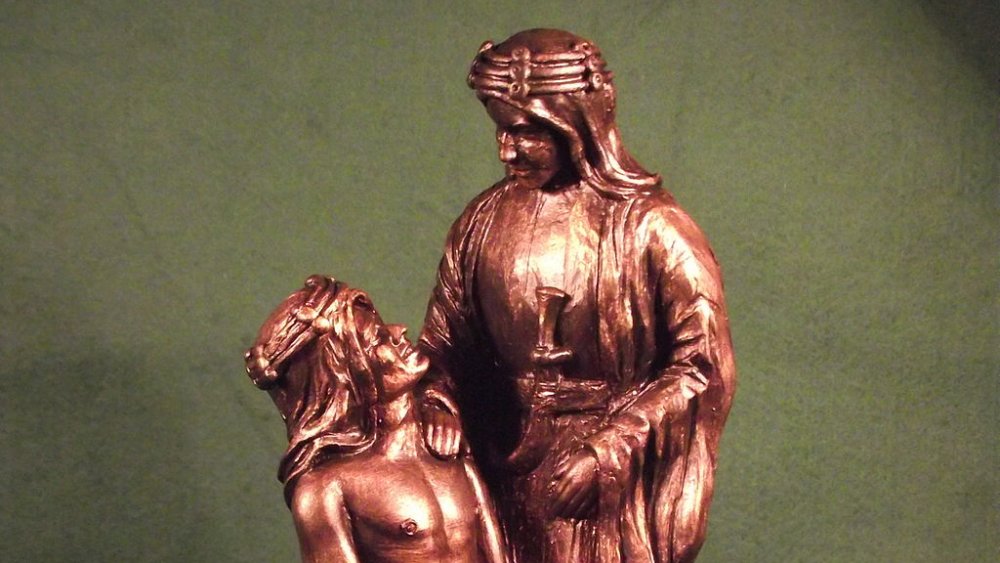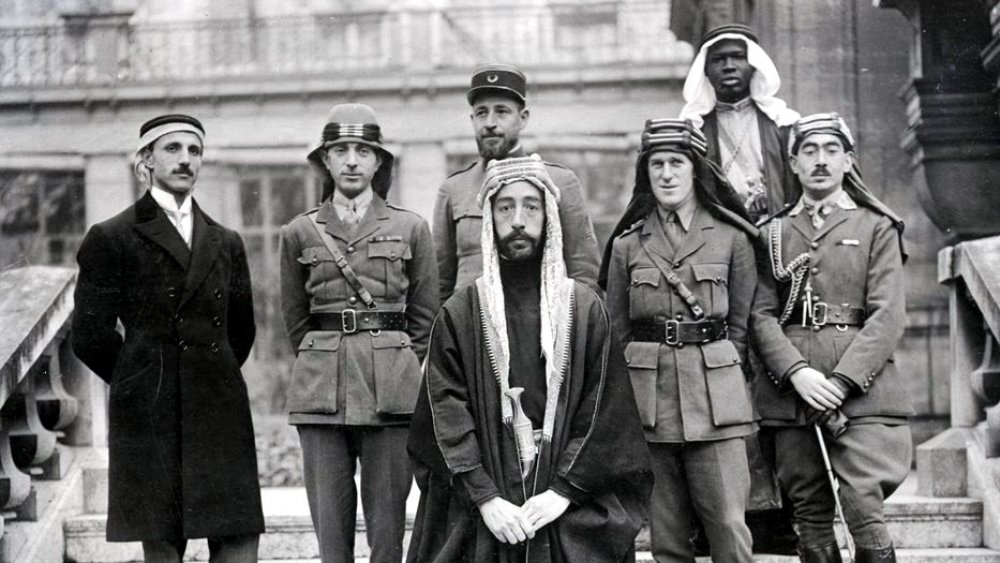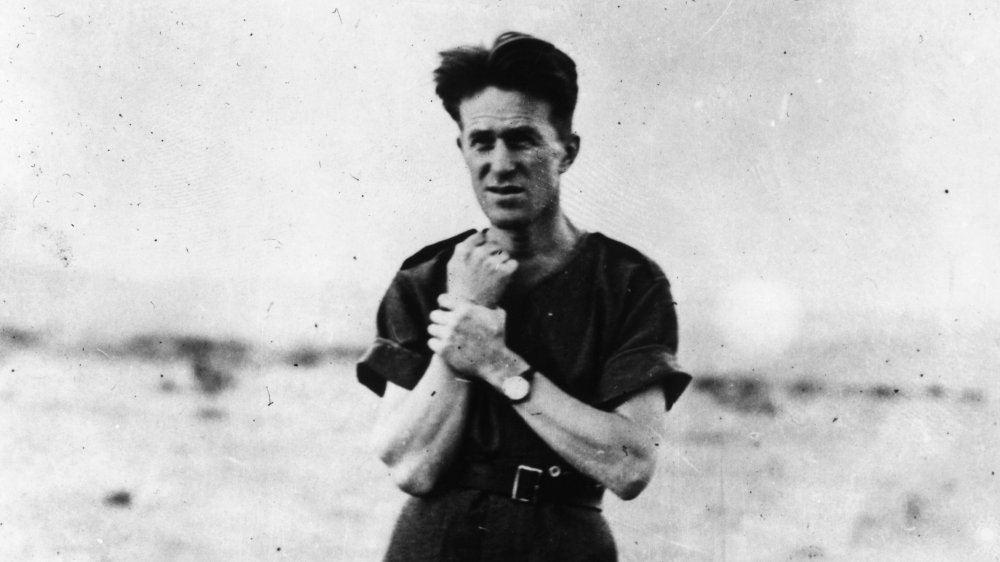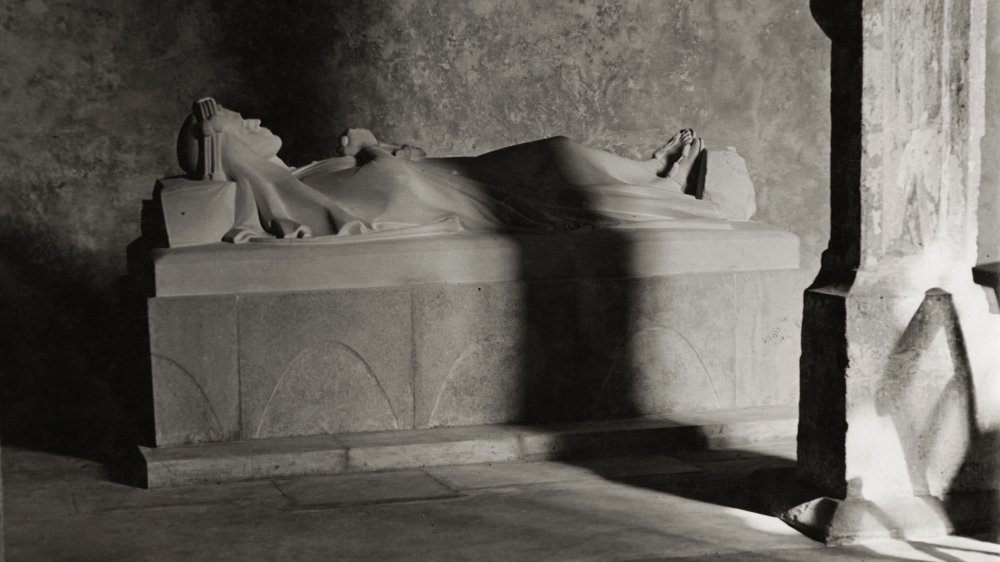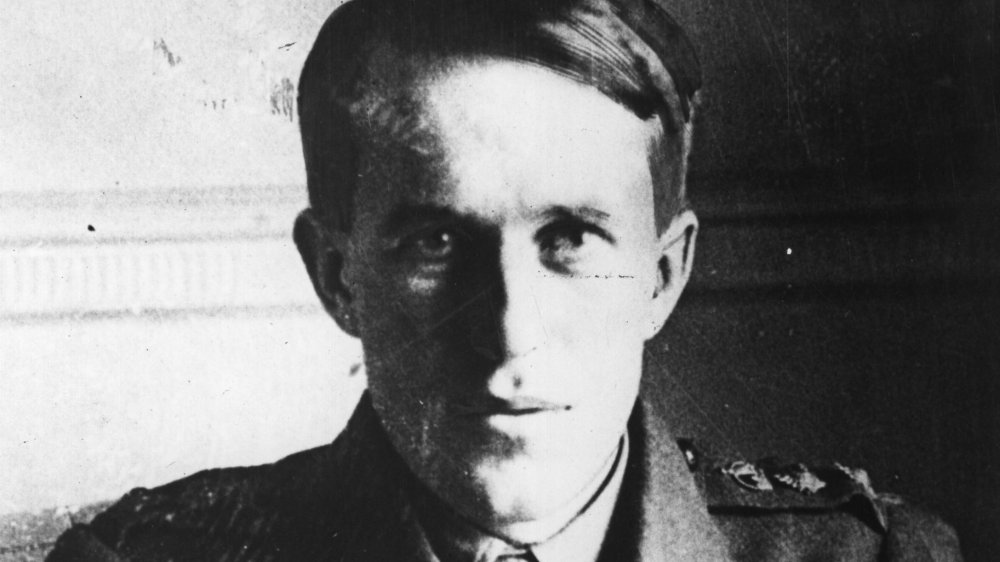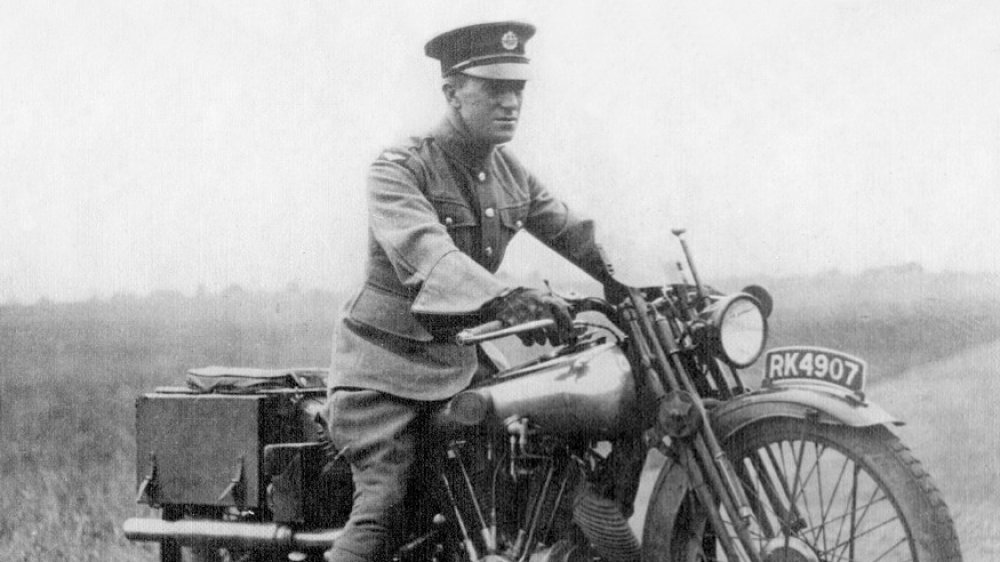The Tragic Real-Life Story Of Lawrence Of Arabia
The incredible and too-short life of the British archaeologist-turned-turbaned freedom warrior Thomas Edward Lawrence inspired countless films, including a much-lauded 1966 biopic starring Peter O'Toole (who was very drunk during filming), and almost certainly the Indiana Jones franchise. Lawrence, dubbed "Lawrence of Arabia" by the press following his time embedded with Arab insurgents in their fight against the Ottoman Turks, was a renaissance man. Fluent in seven languages, he worked not only as an archaeologist but as a fighter pilot, intelligence officer, diplomat, and military strategist. His talents were immense, but so were his demons. He chronicled the former in his autobiography, The Seven Pillars of Wisdom, which, when it came out in 1926, was an instant bestseller and helped propel Lawrence to international fame. As for his demons, they remained largely hidden until his death in a motorcycle accident it the age of 46.
Despite his swashbuckling lifestyle, Lawrence did not seek the spotlight, and, in fact, when he was offered a knighthood and the Victoria Cross for "valor in the presence of the enemy," he declined both, opting instead to join the Royal Air Force as an enlisted man under an assumed name.
But the Lawrence of Arabia the public knows — larger than life, braver than brave, nearly without fault — is only a small part of the story.
T. E. Lawrence's childhood was borderline abusive
Lawrence's beginnings were, according to this biographical profile, quite scandalous for Victorian Britain. His father, the Irish nobleman Thomas Chapman, left his wife and two daughters to elope with their Scottish governess, Sarah Junner. The pair then adopted the name "Lawrence" and lived under it as husband and wife, eventually having five sons together. T. E. was born August 16, 1888 in Wales. Later, the family moved to Oxford. It was in that mecca of academic achievement Lawrence grew up, a curious and preternaturally intelligent boy. It could have been an idyllic childhood. Instead, it was a deeply confusing time.
Sarah Lawrence was a strict and exacting woman, and, as this piece on T. E.'s youth shows, prone to fits of violence. A child of sin herself and a devout Christian, Sarah was never able to reconcile the fact she and Chapman were not married, and she might have taken some of her self-hatred out on her sons. Regardless of her motives, T. E.'s youngest brother, Arnold, once remarked that the Lawrence boys' tumultuous childhood was harder on T. E. than the war. Some of that trauma was the result of great expectations. Sarah thought T.E. was destined for an extraordinary life. It wasn't enough that he be a high achiever; he had to be perfect. Eventually, T. E. moved out of the family home and into a cottage at the edge of the property.
T. E. Lawrence lost two brothers in World War I
Lawrence grew up the second of five boys born to Thomas Chapman and Sarah Junner. It was, thanks in no small part to the fact that his parents were unmarried and trying to hide that fact, an unsettled childhood. Still, as this Historynet piece points out, Lawrence thrived as a student, first in high school and later at Oxford where he studied history and wrote his thesis on Crusader castles. When World War I broke out, Lawrence was on an archaeological dig in Syria. The British Army assigned him to the map-making department in Cairo where, again, Lawrence distinguished himself. He was quick-witted and knowledgeable. He was also discontented.
A desk job wasn't enough for the driven Lawrence. He was anxious to do more, especially after his brothers, Will and Frank, were killed in action on the Western front. According to this survey of Lawrence's life, losing Will and Frank was one of his main motivations for joining the Arab Revolt against Turkish forces in 1919.
He felt horribly guilty that his brothers had sacrificed their lives for the cause of freedom and wanted to be part of history rather than just a witness to it. In serving as right-hand man to Prince Emir Feisal, Lawrence would get what he wanted and much more.
Lawrence of Arabia co-authored his own fame and then despised it
In 1916, Arabs living in the Hejaz region of what is now Saudi Arabia, launched a revolt against the oppressive practices of the Ottoman Empire. Because the Ottoman Empire had aligned itself with Germany, the British took the side of the Arabs, sending T. E. Lawrence to the conflict zone to act as a liaison officer to Prince Feisal, the son of Sharif Hussein of Mecca. According to this review of a recent biography in the Christian Science Monitor, Lawrence, having eschewed Western dress for flowing robes and the keffiyeh headpiece, led a motley band of fighters to an unlikely victory, relying primarily on a set of guerrilla tactics Lawrence invented himself.
His battlefield heroics caught the attention of the American journalist Lowell Thomas, who, as this PBS piece details, saw in Lawrence a dashing matinee idol sure to capture the public's imagination. Thomas filmed Lawrence on location in Feisal's camp and turned that footage into a reel he debuted in New York and London. Lawrence later accused Thomas, whom he described as "a vulgar man," of exploiting his image. Lawrence's fame only grew when he published his memoir, The Seven Pillars of Wisdom, in 1926. The press and the public hounded him. He became, at 30, a reluctant celebrity. Having spent his youth courting adventure and attention, he now entered the Royal Air Force and the tank corps as an enlisted man under a series of assumed names.
Lawrence of Arabia's legacy is checkered
On one hand, hundreds if not thousands of Arab soldiers and compatriots considered T. E. Lawrence an inspiration and a hero. The same can be said for school kids growing up in 1920s and 1930s Britain and America. Lawrence was undoubtedly brave and dashing and brilliant. Having received absolutely no combat training before he joined up with Prince Feisal in his fight against the Turks, Lawrence showed himself to be a cunning and often ruthless military strategist.
On the other hand, Lawrence was a product of his time. He embraced the Arab culture, tossing aside his suits in favor of robes and embroidered vests and the fettiyeh head piece. But, according to Commonweal Magazine, he could be cruel in his attitude toward Arabs he considered beneath him. He was, in some ways, a classic colonialist, dismissing 20th century Arabs as illogical and city Arabs as not worth knowing. He wrote in his memoir, "The perfectly hopeless vulgarity of the half-Europeanised Arab is appalling. Better a thousand times the Arab untouched."
In addition, many of the guerrilla warfare tactics that he invented for use against the much more powerful Turks, including improvised explosive devices or IEDs and the strategic and systematic destruction of lines of communication, are still used today, particularly in Middle Eastern conflicts. Meaning that Lawrence might have been successful in helping Arabs fight the Turks, but he also undeniably has modern blood on his hands.
T. E. Lawrence was forced to execute a member of his own band
In January 1917, Lawrence, by then embedded with the Bedouins, had one of his best days as a leader in the so-called Arab Revolt and one of his worst. The month began with a successful raid on Turkish soldiers in which, according to this examination of his life and legacy, Lawrence and a group of 35 armed tribesmen were able to capture two Turks and bring them back to their camp for questioning. It ended, however, with Lawrence feeling like he had no choice but execute a member of his own militia in order to forestall a blood feud. The killing haunted Lawrence the rest of his life.
During this time, Lawrence was very ill, struggling with boils, dysentery, and malaria. He was also plagued with uncertainty about the mission. He worried constantly that, as he and his band of brothers swept across the desert toward the coastal city of Aqaba, blowing up railways and collecting Bedouin soldiers as they marched, that it was all for naught, that the Arabs were being played for fools, and he wrote in his personal journal that he wanted nothing more than to flee the fight or be killed.
Neither happened, of course, and Lawrence remained in the fray until the bitter end.
Lawrence of Arabia lost a good friend -- and possibly a lover -- to starvation
In his memoir, The Seven Pillars of Wisdom, Lawrence writes lovingly of a man named Selim Ahmed, nicknamed Dahoum, which, in Arabic, means "the little dark one." According to PBS, Lawrence met Dahoum while on an archaeological dig in Carchemish on what is now the Turkey/Syria border. Lawrence was impressed with the young man's intelligence and started giving him English and math lessons. In return, Dahoum taught Lawrence Arabic. The two were inseparable for several years, going on expeditions together and fueling rumors that their relationship was not strictly platonic.
In June 1914, Lawrence left Dahoum behind in Carchemish in order to serve as a liaison between the British Army and the Arab rebels fighting Turkish forces. Four years later, while Lawrence prepared for the pivotal battle for Damascus, he heard that Dahoum had died of typhus during a famine that wiped out thousands of lives in 1916 and 1917.
When all the fighting was over and Lawrence was back in his native Britain, he dedicated The Seven Pillars to "S. A.," whom most scholars believe was Selim Ahmed. And Lawrence prefaced the book with a poem in which he claims that his stint as a soldier was always motivated by his love for "S. A.," writing, "I loved you so I drew these tides of men into my hands and wrote my will across the stars to earn you Freedom."
T. E. Lawrence felt as if he'd betrayed his Arab allies
Almost from the beginning of the Arab revolt against the Turks, Lawrence had misgivings about how the conflict would end and what sort of life his Arab friends could count on, once Britain and France became involved. As this piece from the UK's National Army Museum shows, Lawrence, who attended the Paris peace talks in 1919 and the Cairo conference in 1921 — both of which were convened at least in part to negotiate Arab independence — was deeply disappointed in the outcomes of such discussions. Rather than hammer out the details of a peace agreement with Arabs in good faith, British and French dignitaries simply divvied the Middle East up between them. This mockery of diplomacy became known as the Sykes-Picot agreement.
Lawrence, still intent on furthering the Arab caused, went to work for Winston Churchill in 1920 to try to exert some influence, but it was all to no avail and he ended up so disillusioned that, according to the Virginia Quarterly Review, he declared Arab unity "a madman's notion." Around this time, as reported by the New York Times, a Scotsman confessed to the London Sunday Times that Lawrence hired him to administer periodic beatings. Whether this sadomasochistic behavior was guilt-based and tied somehow to Lawrence's powerlessness in the face of imperial Britain and France — or if it was strictly sexual — is unknown and a matter of some speculation.
Having lived through a dangerous Arab revolt, T. E. Lawrence almost died in a plane crash
In May 1919, Lawrence was on his way from Paris to Cairo to collect his notes so that he could begin writing the memoir that would become The Seven Pillars of Wisdom. The trip took him to Italy's Centocelle Airport where, according to a historical record courtesy of the Aviation Safety Network, the pilot was befuddled by darkness and unpredictable winds. The pilot overshot the runway and tried to land again, but ended striking a tree with one of the wings. The plane plummeted to the earth, killing one pilot instantly. The other died later in the hospital. Their names were lieutenant Frederick George Prince and lieutenant Sydney Spratt.
Lawrence was lucky. He survived his brush with death and suffered only a broken shoulder blade and two broken ribs, although the rib injury bothered him the rest of his life. Later, he sent another survivor, crew member F. J. Daw, a £10 note as a thank you for helping him exit the plane (mostly) unharmed.
Lawrence of Arabia most likely lived his entire life in the closet
T. E. Lawrence had all the qualities of a leading man of stage and screen. He seemed to live his life in search of the next grand adventure. First, he served as an archaeologist, unearthing ancient Middle Eastern antiquities for the British Museum. Later, he joined the British Army as an intelligence officer. That work led him to the battlefield, where, alongside kings, princes, and tribesmen, he helped an oppressed people defeat their Turkish overlords. So far, so dreamy. And so very masculine, at least in the conventional, Victorian understanding of the term.
What many casual fans might not know is Lawrence was almost certainly homosexual. In his memoir, The Seven Pillars of Wisdom, he waxes lyrical about his friend, Selim Ahmed, referred often by Lawrence by the term of endearment "Dahoum," or "little dark one," and he takes no small pleasure in the company of two very closely bonded young Arab servants, of whose obvious attachment he makes this observation: "They were an instance of the eastern boy and boy affection which the segregation of women made inevitable. Such friendships often led to manly loves of a depth and force beyond our flesh-steeped conceit. When innocent they were hot and unashamed."
Lawrence, it would appear, was not unashamed. He was successful in keeping his sexuality hidden from the public until his early death in 1935. Even now, whether he was gay or perhaps asexual is up for debate.
T. E. Lawrence was kicked out of the Royal Air Force
Back from the battlefield and having gotten his fill of fame, T. E. Lawrence tried to retreat to private life and, in 1922, entered the Royal Air Force under the assumed name, John Hume Ross. According to History, Lawrence only spent a few months as a pilot. The press outed him as Lawrence of Arabia, even going so far as to suggest he might be working as a spy in India, and he was kicked out of the service.
Lawrence was not one to rest on his laurels. He soon entered the Royal Tank Corps, again under an assumed name. This time he picked Thomas Edward Shaw, in homage to the Irish playwright and Lawrence's good friend, George Bernard Shaw. Lawrence was — again — discovered and expelled from the tank corps, too. His plan to become a recluse wasn't going so well.
In 1925, he reenlisted in the RAF. Ten years later, he retired, having finally, it seemed, achieved his goal of near obscurity. He was, at this time, living in a small, spartan cottage in Dorset. He had no time to enjoy his freedom, though. A few months after his retirement, he was killed in a high-speed motorcycle crash.
Lawrence of Arabia died in a motorcycle crash (that might not have been an accident)
T. E. Lawrence was an unabashed motorbike enthusiast. According to the Telegraph, he owned eight expensive and state-of-the-art Brough Superior motorcycles, the "Rolls-Royces of motorcycles." On the morning of May 13, 1935, Lawrence, known to try to race a plane on occasion, was speeding through his neighborhood of Dorset when he spotted two boys on bicycles. He swerved to avoid the boys, sideswiping one of them. The impact caused Lawrence to hurtle over his bike's handlebars and, six days later, he died of his injuries. (His death would actually save lives, by leading to research into helmet usage.)
The circumstances of the accident itself seemed rather cut-and-dry back in 1935, but a letter he wrote to the head of the Royal Air Force's publicity department, unearthed decades after his death, has some scholars wondering if the crash wasn't actually deliberate on Lawrence's part. In the letter, Lawrence wrote that, facing retirement from the RAF, he wished he were dead. He also expressed dismay at the prospect of trying to find another job. He knew the press would follow him wherever he went and ruin his chances of success. He ended the letter by saying he did not want to grow old. Ever.
Tragic irony of ironies, Lawrence got his wish, and the world was robbed of one of its most legendary and intriguing figures. Of course, nothing feeds legend and intrigue like an early death.
